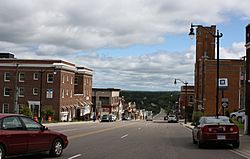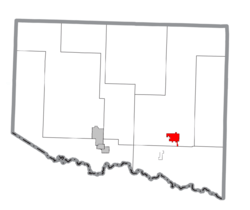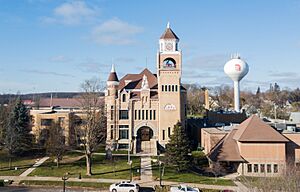Crystal Falls, Michigan facts for kids
Quick facts for kids
Crystal Falls, Michigan
|
|
|---|---|

Looking east at downtown Crystal Falls
|
|

Location within Iron County
|
|
| Country | United States |
| State | Michigan |
| County | Iron |
| Area | |
| • Total | 3.64 sq mi (9.42 km2) |
| • Land | 3.49 sq mi (9.05 km2) |
| • Water | 0.14 sq mi (0.38 km2) |
| Elevation | 1,476 ft (450 m) |
| Population
(2020)
|
|
| • Total | 1,598 |
| • Density | 457.62/sq mi (176.66/km2) |
| Time zone | UTC-6 (Central (CST)) |
| • Summer (DST) | UTC-5 (CDT) |
| ZIP code |
49920
|
| Area code(s) | 906 |
| FIPS code | 26-19140 |
| GNIS feature ID | 0624170 |
Crystal Falls is a city in Michigan, and it's the main town for Iron County. In 2020, about 1,598 people lived there. The city is inside Crystal Falls Township, but it's a separate place with its own government.
This area first grew because of its important iron mining and timber industries. In recent years, it has become a popular spot for tourists.
Contents
History of Crystal Falls
Crystal Falls was officially mapped out in 1881. It got its name from a beautiful, icy waterfall nearby on the Paint River. A post office has been open in Crystal Falls since 1885.
Geography and Climate
Crystal Falls covers about 3.6 square miles (9.4 square kilometers). Most of this area is land, with a small part being water. The city has many hills. The old county courthouse, which looks like a castle and was built in 1890, sits on the highest point. From there, it looks down over the main part of the city.
Weather in Crystal Falls
The weather in Crystal Falls sees rain and snow throughout the year. The warmer months, from April to September, get most of the rain. June is usually the wettest month, while February is the driest.
Thunderstorms happen about 33 days a year. There are usually around 139 days with some measurable rain or snow.
The average snowfall each winter is about 70 inches (1.79 meters). There are many days each winter when there's at least one inch of snow on the ground. The most snow ever recorded in one day was 18 inches (45.7 cm) in March 1926.
Even though there are no longer official weather stations in Crystal Falls, temperatures are similar to those in Marquette, Michigan. The highest temperature ever recorded was 99 degrees Fahrenheit (37 degrees Celsius). The lowest was -42 degrees Fahrenheit (-41 degrees Celsius).
On average, Crystal Falls has about 4 days a year that are 90 degrees Fahrenheit (32 degrees Celsius) or hotter. It also has many days below freezing, and about 55 days a year where the temperature drops below 0 degrees Fahrenheit (-18 degrees Celsius). Freezing temperatures can happen in any month except July.
| Climate data for Crystal Falls, Michigan | |||||||||||||
|---|---|---|---|---|---|---|---|---|---|---|---|---|---|
| Month | Jan | Feb | Mar | Apr | May | Jun | Jul | Aug | Sep | Oct | Nov | Dec | Year |
| Mean daily maximum °F (°C) | 20.8 (−6.2) |
26.3 (−3.2) |
36.5 (2.5) |
50.5 (10.3) |
65.8 (18.8) |
74.0 (23.3) |
78.6 (25.9) |
75.9 (24.4) |
66.2 (19.0) |
53.7 (12.1) |
37.4 (3.0) |
25.1 (−3.8) |
50.9 (10.5) |
| Mean daily minimum °F (°C) | −2.1 (−18.9) |
1.0 (−17.2) |
12.2 (−11.0) |
26.0 (−3.3) |
37.6 (3.1) |
47.0 (8.3) |
51.7 (10.9) |
50.3 (10.2) |
41.9 (5.5) |
32.3 (0.2) |
20.9 (−6.2) |
6.4 (−14.2) |
27.1 (−2.7) |
| Average precipitation inches (mm) | 1.24 (31) |
0.82 (21) |
1.79 (45) |
2.17 (55) |
2.92 (74) |
3.86 (98) |
3.57 (91) |
3.59 (91) |
3.66 (93) |
2.67 (68) |
2.01 (51) |
1.35 (34) |
29.65 (753) |
| Source: "Climatography of the United States," National Climatic Data Center (www.ncdc.noaa.gov) | |||||||||||||
People of Crystal Falls
| Historical population | |||
|---|---|---|---|
| Census | Pop. | %± | |
| 1900 | 3,231 | — | |
| 1910 | 3,775 | 16.8% | |
| 1920 | 3,394 | −10.1% | |
| 1930 | 2,995 | −11.8% | |
| 1940 | 2,641 | −11.8% | |
| 1950 | 2,316 | −12.3% | |
| 1960 | 2,203 | −4.9% | |
| 1970 | 2,000 | −9.2% | |
| 1980 | 1,965 | −1.7% | |
| 1990 | 1,922 | −2.2% | |
| 2000 | 1,791 | −6.8% | |
| 2010 | 1,469 | −18.0% | |
| 2020 | 1,598 | 8.8% | |
| U.S. Decennial Census | |||
Population in 2010
In 2010, there were 1,469 people living in Crystal Falls. They lived in 700 homes, and 402 of these were families. Most of the people (about 97%) were White. A small number were Native American, Asian, or from other backgrounds.
About 22% of homes had children under 18. Many homes (about 42%) were married couples living together. About 40% of homes were single people, and many of them were 65 or older. The average age of people in Crystal Falls was about 48 years old.
Fun Things to Do
Crystal Falls is home to the Crystal Theater. This is a special place where people can watch plays, concerts, and other performances.
The city used to have many people who had served in the military. They would celebrate a special day called V-J Day. Now, Crystal Falls has two big festivals in the summer. One is a "bass" festival with fun activities and a marathon. The other is a "mushroom festival," which replaced the V-J Day celebrations.
In late February, many locals look forward to the annual Fisheree tournament. This event takes place on the frozen Michigamme reservoir.
The Humongous Fungus
In April 1992, Crystal Falls became famous around the world. This happened because a giant fungus, called Armillaria bulbosa, was found in a nearby forest. News about this discovery appeared in important science magazines and newspapers.
This fungus, known as the "humongous fungus," covered an area larger than 30 acres (120,000 square meters). Scientists thought it weighed about 100 tons. At the time, it was believed to be one of the oldest and largest living things on Earth!
Even though the fungus is actually in a nearby area called Mastodon Township, Crystal Falls adopted it as a tourist attraction. The city now holds an annual "Humungous Fungus Fest" to celebrate this amazing discovery.
Getting Around
You can reach Crystal Falls using these main roads:
 US 2
US 2 US 141
US 141 M-69
M-69
There is also a bus service called Indian Trails. It provides daily trips between St. Ignace and Ironwood, Michigan.
Gallery
See also
 In Spanish: Crystal Falls (Míchigan) para niños
In Spanish: Crystal Falls (Míchigan) para niños






